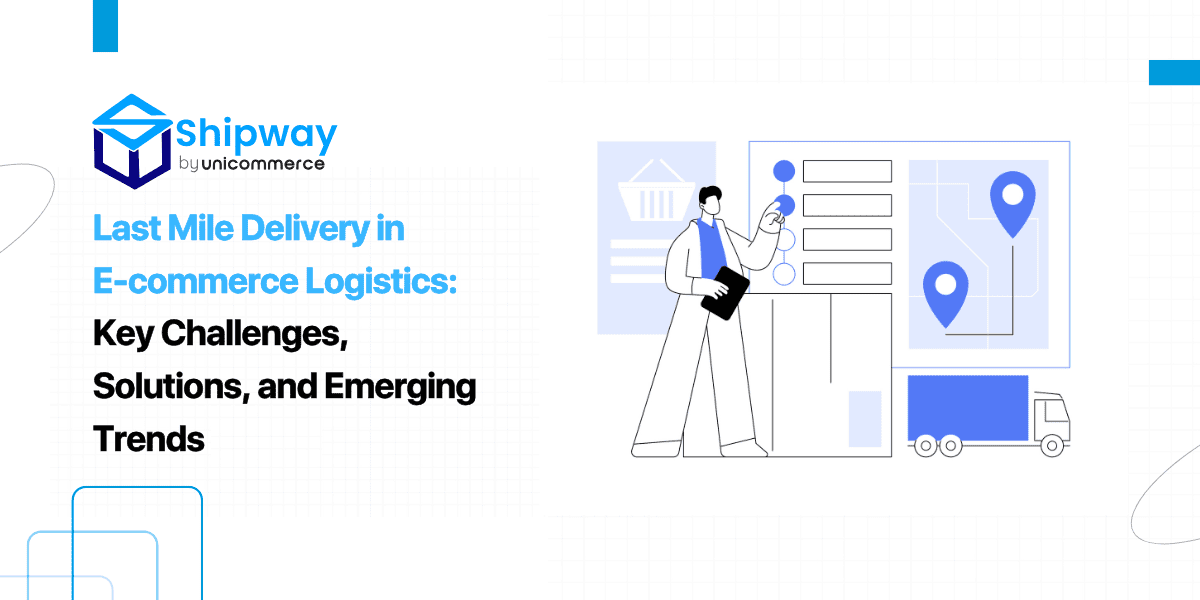These are the everyday doubts brands face in managing last-mile delivery. While it plays a decisive role in customer satisfaction and retention, it also exposes businesses to rising costs, inefficiencies, and operational risks. In this blog, we’ll break down the key challenges of last-mile delivery and discuss practical solutions to overcome them in 2025.
What is Last-Mile Delivery?
Last-mile delivery is the final stage of the logistics chain where products are transported from a distribution center to the customer’s address. It is often the most expensive step because of issues like traffic, multiple delivery stops, and failed attempts.
Steps involved in last-mile delivery:
The customer places an order through the e-commerce platform or retail store.
1. Order Processing
The business prepares the order and hands it over to the assigned delivery partner.
2. Hub Allocation & Route Planning
Dispatch managers at the transport hub assign the order and plan the most efficient delivery routes.
3. Tracking
Tracking ensures real-time visibility of orders, keeping customers updated on status, ETA, and delays through GPS-enabled systems.
4. Order Scanning & Loading
On-ground staff scan the package and load it into the delivery vehicle for dispatch.
5. Final Delivery
The courier delivers the order to the customer’s doorstep, completing the last-mile journey.
Key Challenges in Last Mile Delivery
From high costs to missed deadlines, last-mile delivery comes with hurdles that can make or break the customer experience.
1. Hidden Expenses That Drive Up Delivery Costs
Let’s say, an e-commerce brand delivering to a Tier-2 city during the festive season sends out a delivery van covering 30 kilometers with parcels scattered across different neighborhoods. Midway, one customer cancels the order, while another refuses a COD package.
How costs rise in such situations:
- High operational costs from fuel, labor, and vehicle maintenance despite low delivery density.
- Loss of revenue from cancellations and COD refusals, while expenses remain unchanged.
- Increased delivery time due to multiple small stops, which reduces efficiency.
Scenarios like these drive up the overall cost of last-mile delivery. On top of that, factors such as rising fuel prices, vehicle maintenance, labor charges, and other hidden operational expenses further increase the financial burden on businesses.
2. Remote Location Delivery
Tracking is a vital part of last-mile delivery, but in many cases, it becomes one of the biggest hurdles. Deliveries to remote or underdeveloped areas often suffer due to poor infrastructure, lack of reliable roads, or extreme weather conditions that disrupt movement. These factors make it harder for logistics companies to provide accurate and timely tracking updates.
Challenges in remote location delivery-:
- Limited network connectivity
- Weak mobile coverage prevents real-time updates
Scenarios like this create uncertainty about delivery times and lead to more WISMO (Where Is My Order) calls.
3. When Seasonal Demand Overloads Logistics
Festive and holiday periods bring a sharp rise in online orders, putting enormous pressure on logistics networks. When delivery volumes suddenly spike, businesses often face delays, missed shipments, or errors in order handling. To keep up, many companies hire temporary staff or add extra vehicles, but this increases costs and complicates operations. For example, during Diwali or Christmas sales, a courier partner handling double the usual load may still struggle to deliver on time, resulting in dissatisfied customers and higher return rates.
Challenges faced during peak season:
- Missed shipments
- Errors in order handling
- Wrong address deliveries
- Failed delivery attempts
- Damaged parcels
- High RTO rates
- Delayed updates in tracking
- Customer refusals (especially COD)
4.Managing Reverse Logistics
Returns are one of the trickiest parts of last-mile delivery. When customers send products back, whether due to size issues, damaged items, or simply a change of mind, it creates an extra layer of work for delivery partners and sellers. Managing pickups, processing refunds, and updating inventory all require time and resources, which naturally push up costs. Transportation is the biggest contributor here, accounting for nearly 60% of overall reverse logistics expenses.
Challenges faced
- High transportation costs due to additional pickup trips.
- Increased labor requirements for handling returns and inspections.
- Difficulty in coordinating reverse pickups in remote or low-density areas.
- Risk of damaged goods during return transit, reducing resale value.
5.Lack of Smart Tools and Technologies
A major reason many logistics companies struggle with last-mile delivery is their reliance on outdated systems. Without modern tools, it becomes harder to optimize routes, track shipments in real time, or respond quickly to disruptions. In fact, studies show that almost half of transportation and logistics providers still operate on legacy technology, limiting their efficiency and increasing costs. Embracing digitalization, such as AI-driven route planning, automated tracking, and advanced analytics, can transform the last mile into a faster, more cost-effective process.
Challenges Faced with Outdated Systems:
- Limited visibility into delivery status.
- Inefficient route planning and higher fuel costs.
- Delays in responding to issues like traffic or failed deliveries.
Solutions to Overcome Last Mile Delivery Challenges
Last-mile delivery challenges may seem unavoidable, but with the right strategies and tools, businesses can minimize costs, reduce inefficiencies, and deliver a smoother customer experience. While these solutions are vital, managing them individually can become complex. This is where an integrated platform makes all the difference.
Shipway acts as an all-in-one e-commerce shipping aggregator, bringing together courier allocation, tracking, NDR management, returns automation, and more under a single system. Centralizing logistics operations helps businesses not only overcome last-mile challenges but also reduce hidden costs and deliver consistently better customer experiences.
1. Smart Ways to Reduce Hidden Expenses
In e-commerce, hidden logistics costs often creep in through repeat delivery attempts, customer support overhead, shipping errors, and inefficient returns. These costs not only eat into profit margins but also create friction in the customer experience. Shipway tackles these challenges head-on by automating processes, improving visibility, and streamlining operations, ensuring businesses save money while keeping customers satisfied.
Key Ways Shipway Reduces Hidden Costs:
Automated Tracking & Notifications
By sending real-time updates to customers about their order and refund status, Shipway reduces “Where is my order?” (WISMO) calls and support tickets. This cuts down the workload for customer service teams and saves on support costs.
Operational Efficiency Through Automation
Features like bulk label generation, centralized order sync, packaging recommendations, and AI-based courier selection minimize manual effort and reduce human error. This not only speeds up fulfillment but also lowers costs tied to delays and rework.
Fewer Shipping Errors & Disputes
With Shipway’s branded tracking page and dispute management features, businesses gain better visibility into undelivered orders and empower customers to raise concerns directly. This reduces chargebacks, compensation claims, and dispute-related losses.
Smarter NDR Management
Shipway’s NDR Management Panel consolidates all non-delivery reports in one place, enabling businesses to proactively confirm re-attempts with customers. This avoids unnecessary trips, prevents inventory from getting stuck, and reduces re-delivery expenses.
2. Smarter Logistics for Reaching Remote
Delivering to remote or underserved locations is one of the biggest hurdles in last-mile logistics. Poor connectivity, limited courier coverage, and higher RTO (Return to Origin) rates often lead to increased costs and lower efficiency. Shipway addresses these challenges by leveraging its wide network, smart courier allocation, and AI-driven tools to make remote deliveries smoother and more cost-effective.
Key Ways Shipway Supports Remote Location Deliveries:
Broad Pin Code Reach
Shipway’s network covers over 29,000 pin codes, ensuring businesses can deliver to Tier II, Tier III, and rural markets without depending on a single courier. This helps brands expand reach and capture new customer segments.
Multiple Courier Integrations
With pre-integrated partners like Delhivery, Bluedart, DTDC, and Xpressbees, merchants can choose the most reliable carrier for each pin code. This flexibility ensures better serviceability in remote areas.
Smart Carrier Allocation
Shipway’s system automatically assigns orders to the most cost-effective and serviceable courier by analyzing the delivery pin code, performance data, and pricing. This reduces logistics costs while ensuring timely deliveries.
Reducing RTOs in Remote Areas
COD orders in remote regions often face higher RTO rates. Shipway uses AI-based fraud detection to flag risky COD orders early, improving delivery success rates and minimizing losses from failed shipments.
3. Leverage Returns to Improve Customer Experience
Returns and refunds are often the trickiest part of last-mile delivery, but with Shipway, brands can simplify the process and keep customers satisfied. Smooth handling of returns not only reduces operational headaches but also builds long-term trust.
Here is How Shipway Helps:
Partial Returns
Allow customers to return selected items from a multi-product order instead of sending the entire shipment back.
Refund & Exchange Options
Provide flexible refund choices such as store credits, UPI, bank transfer, Paytm, or even gift cards, making the process hassle-free.
Image Uploads
Enable customers to upload product images while raising a return request, helping reduce disputes and streamline verification.
Quick Refund Processing
Integrate with partners like Cashfree to validate bank or UPI details and ensure faster refund settlements, reducing customer anxiety.
Seamless Experience
Shipway ensures customers get timely updates on their return and refund status, improving transparency and customer confidence.
4.Handling Peak Season Demand
The festive and peak shopping seasons put enormous pressure on logistics networks. High order volumes often lead to errors, delays, and customer dissatisfaction. To keep operations running smoothly and maintain customer trust, businesses need tools that ensure speed, accuracy, and visibility in deliveries.
Here’s how Shipway’s advanced help tackle these seasonal challenges:
- Real-Time Tracking Through Shipping Labels
With barcode-enabled labels, customers can track their packages in real time throughout the delivery journey. For businesses, these barcodes streamline warehouse operations by making it easier to pick, scan, and dispatch the right product quickly, even during high-demand periods. This minimizes errors and accelerates order fulfillment.
- Same-Day and Next-Day Delivery Options
During peak season, customers expect faster deliveries without compromise. Offering same-day and next-day delivery across metro cities boosts fulfillment performance and ensures higher customer satisfaction. Faster turnaround not only meets festive demand but also reduces cart abandonment by giving shoppers confidence in timely delivery.
Wrapping Up
Last-mile delivery remains one of the most complex and cost-heavy parts of e-commerce logistics, shaping both customer satisfaction and profitability. From high operational costs and remote location hurdles to seasonal surges and reverse logistics, the challenges are many. Yet, businesses that adopt smarter tools, automation, and data-driven strategies can turn these obstacles into opportunities to improve efficiency, reduce costs, and deliver consistently better customer experiences.
Platforms like Shipway make this journey simpler by centralizing courier allocation, tracking, NDR handling, returns automation, and peak-season management under one ecosystem. With solutions designed to reduce hidden logistics costs, strengthen tracking, and support deliveries even in remote areas, Shipway ensures brands can scale with confidence.
In today’s competitive market, mastering last-mile delivery is not just about faster shipping; it’s about building trust and loyalty at every doorstep. Ready to make your logistics smarter? Start streamlining last-mile delivery with Shipway today.
What is last-mile delivery in e-commerce logistics?
Why is last-mile delivery so costly for businesses?
What challenges do e-commerce businesses face in last-mile delivery?
High delivery expenses and operational inefficiencies
Failed deliveries and order refusals (especially COD)
Remote location deliveries with poor infrastructure or tracking issues
Seasonal demand surges, leading to delays and errors
Complex reverse logistics processes and return handling
How does Shipway help solve last-mile delivery challenges?
How can businesses improve last-mile delivery performance?
Brands can adopt smart route planning, real-time tracking, NDR management, and returns automation to reduce costs and improve customer experience. Partnering with aggregator platforms like Shipway helps centralize courier allocation and streamline shipping operations.


